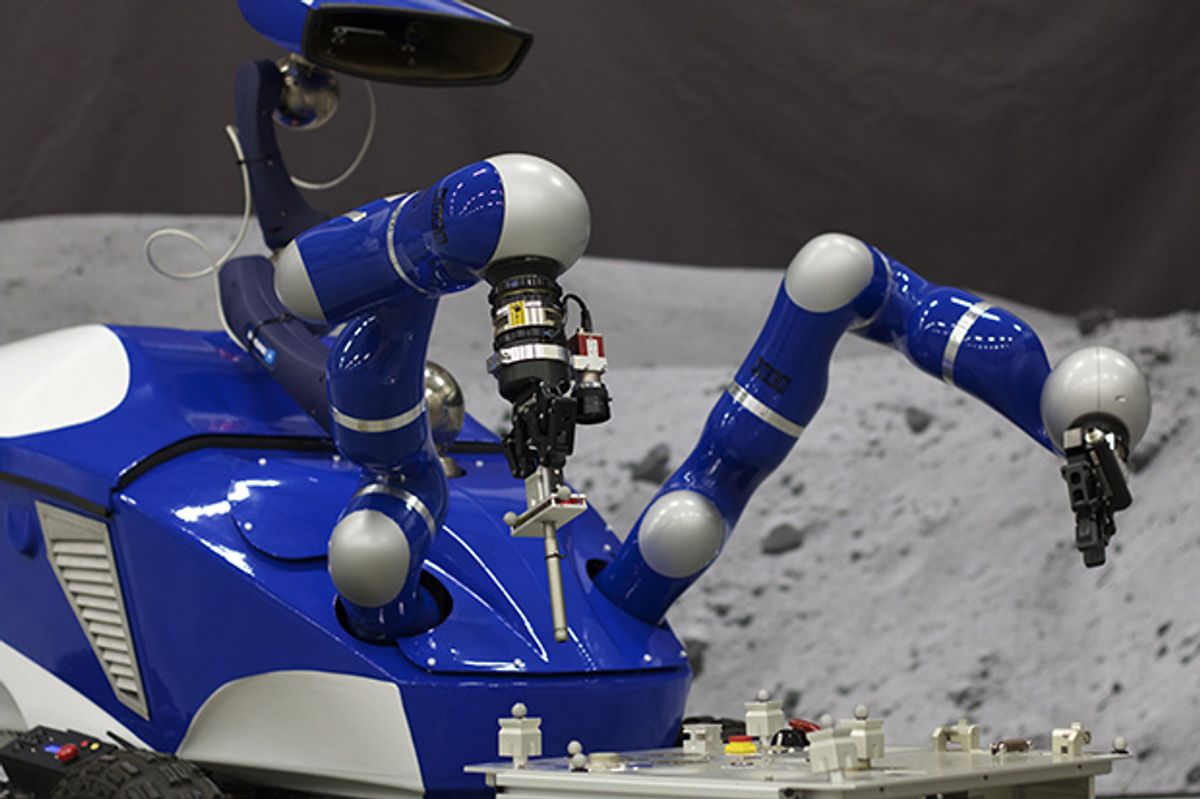The European Space Agency (ESA) and the TU Delft Robotics Institute have been running some tests with astronaut Andreas Mogensen (currently a non-Earth resident up on the International Space Station) remotely controlling some fairly imposing robots from orbit. What’s new is using multiple robots collaboratively, and trying out a new haptic feedback system that lets Mogensen feel what the robot feels. From space.
As with any experiment that depends on the participation of an astronaut, ESA has been preparing for this for a long, long time. Rather than explain everything ourselves, let’s just follow along with Mogensen as he visits ESA’s Telerobotics and Haptics Laboratory in preparation for his ISS mission:
And here are the highlights of the successful teleop experiments:
Putting a round peg in a round hole is not hard to do by someone standing next to it. But on 7 September 2015 ESA astronaut Andreas Mogensen did this while orbiting 400 km up aboard the International Space Station, remotely operating a rover and its robotic arm on the ground. Andreas used a force-feedback control system developed at ESA, letting him feel for himself whenever the rover’s flexible arm met resistance.
These tactile sensations were essential for the success of the experiment, which involved placing a metal peg into a round hole in a ‘task board’ that offered less than a sixth of a millimetre of clearance. The peg needed to be inserted 4 cm to make an electrical connection. Andreas managed two complete drive, approach, park and peg-in-hole insertions, demonstrating precision force-feedback from orbit for the very first time in the history of spaceflight.
ESA astronaut Andreas Mogensen commanding the Eurobot rover from space. As part of ESA’s Meteron project, Andreas a second, car-sized rover from the International Space Station to repair a mockup lunar base in the Netherlands. Andreas directly controlled the Eurobot rover in a simulated troubleshooting Moon scenario. A second rover was controlled by ESA’s centre in Germany, allowing Andreas to focus on Eurobot and intervene if necessary.
The new user interface for operating rovers from space ran perfectly as they worked in harmony at close quarters without any problems. The experiment went so well that it was completed in one continuous session rather than over the planned three sessions on two days.
This kind of teleoperation will certainly come in handy on the Moon and on Mars, where it’s always going to be cheaper to send robots to than fragile, needy humans. Especially if we combine it with haptics, immersive VR, and robots that are more efficient and capable at exploring and sampling than humans are (because they can hop or roll or fly or whatever), you could make the argument that there’s very little downside to not sending humans to do in-situ exploring at all. And when we’re talking about more extreme environments (Mercury, Venus, asteroids and comets, or some of the moons of Saturn and Jupiter), putting humans there may not be an option at all. I certainly recognize the value of having humans experience a place in person, but at the same time, if you have to choose (budgetarily) between sending humans to the surface of Mars or sending humans to both Mars orbit and Venus orbit and leaving the surface of both to teleoperated robots, which one would you pick?
It’s important to remember that due to those pesky laws of physics (namely, the speed of light), anything close to real-time teleoperation is going to require the human to be reasonably close. Without factoring in any other delays, a one-way transmission from Earth to the Moon takes about 1.3 seconds to arrive. This is probably impractical for robots without some amount of autonomy, unless you’re willing to be extremely cautious. From the ISS to Earth isn’t so bad, at just a fraction of a second, but if you were a hardcore gamer you’d probably get frustrated with your ping. What this means is that real-time interactive teleoperation is probably going to require orbital proximity; otherwise, we’re essentially left with what we’re currently doing with the Mars rovers: they have partial autonomy but move very very slowly because of the requirement to transmit imagery to, and then receive instructions from, Earth.
What might be ideal is a hybrid approach: unleashing a swarm of autonomous robots that do their exploration thing, with humans jumping in from orbit whenever a robot spots something interesting. This depends on having a.) a swarm of autonomous robots and b.) humans in orbit, and right now we have neither. But ESA’s recent test is where it all starts, we hope.
[ ESA Telerobotics ]
Evan Ackerman is a senior editor at IEEE Spectrum. Since 2007, he has written over 6,000 articles on robotics and technology. He has a degree in Martian geology and is excellent at playing bagpipes.



